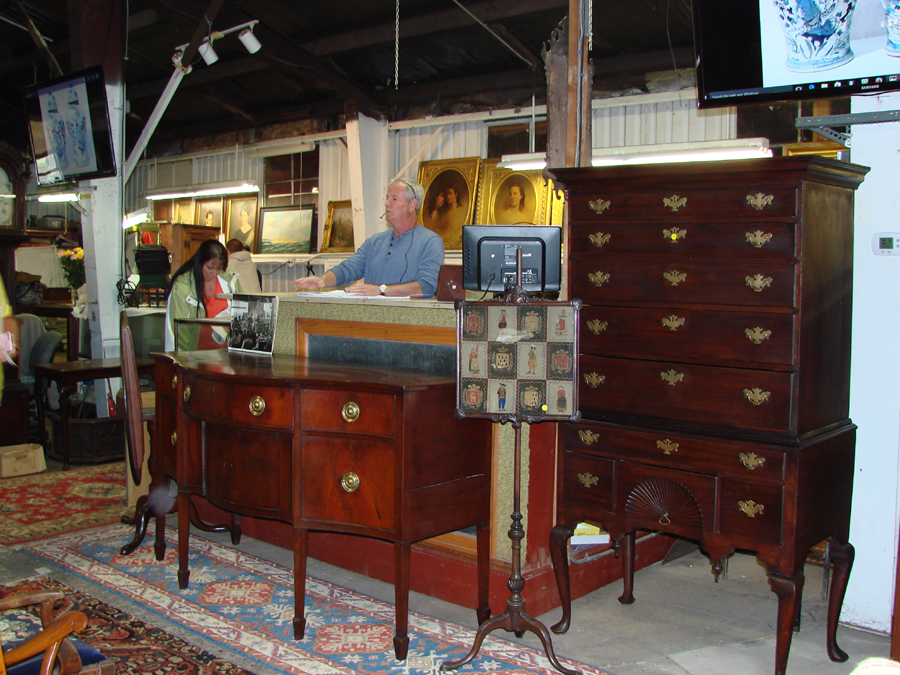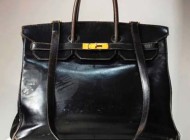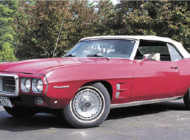Review and Onsite Photos by Rick Russack;
Additional Photos Courtesy Stanton Auctions
HAMPDEN, MASS. — Peter Imler’s April 30 sale included Eighteenth Century American furniture, Oriental rugs and ceramics, folk art, windmill weights, World War I posters and paintings. Topping the sale was a Boston block front kneehole dressing table, which brought $43,125. Imler dated it as 1745–65 and cataloged it as possibly by Boston cabinetmaker George Bright (1727–1805). It had the initials “E.H.” in chalk on the back, and Imler wondered if it might possibly have had a connection to Elias Hasket Derby (1739–99), wealthy merchant of Salem, Mass. It had original brasses, original locks, a comb drawer and an old finish. Imler called it “the best Boston kneehole we’ve ever sold.”
In a conversation prior to the sale, Imler told Antiques and The Arts Weekly, and later told the audience, that after 36 years in the business, he has decided that he will retire at the end of this year. His final auction will be in November, followed by a large, end-of-year tag sale in December. His tag sales are an annual event, but he said, “This year we’ll be selling right down to the walls.” Business is good, he has plenty of merchandise to sell but said, “It’s just time.” He continued, “I’m old school. I liked looking out at a packed salesroom and watching people touching stuff, turning it over and talking about it. The Internet has changed that.” He joked, “Maybe I’ll go to work for my son Dan. His company just sold the 1852 Laws of Baseball for $3.2 million” — referring to Laguna Niguel, Calif.-based SCP Auctions, leading sellers of sports memorabilia, of which his son, Dan Imler, is a principal.

The highlight of the sale was this block front kneehole dressing table, cataloged as possibly by George Bright, Boston, circa 1745-–65, which sold for $43,125. It had original brasses, locks and a comb drawer. Imler termed it “the best Boston kneehole we’ve ever sold.”
Stanton’s sale did not have any seven-figure baseball memorabilia, but there was plenty of good Americana and there were some bargains to be had. In addition to the Boston block front dressing table, there were several other pieces of early American furniture. A Chippendale Rhode Island four-drawer oxbow chest made of Cuban mahogany, cataloged as dating to about 1755–75, with blocked ends and original brasses, went out for $2,587. An early Pennsylvania or New Jersey William and Mary cross stretcher-based lowboy, circa 1700–20, with original brasses, top, legs and feet, brought $4,600. It had been refinished about 40 years ago.
A Queen Anne splat back armchair, circa 1750, from coastal Connecticut, described as being in untouched condition, with bold turnings and rams-horn arms, achieved $1,495. A circa 1725–50 flat-top, shell carved Queen Anne highboy with removable legs, original brasses and original finish, was attributed to Benjamin Frothingham and realized $5,750. Shaker chairs seemed like bargains: a marked #6 rocking chair with arms and original finish fetched $81, and a group of two #3 rocking chairs — one without a seat — reached only $57.
A particularly nice tall case clock of the Simon Willard school in a carved mahogany and satinwood inlaid case, circa 1790–1810, went for $6,900. The painted dial may have been done by John Ritto Penniman, a well-known Boston painter who apprenticed in Roxbury at the age of 11. One of the more interesting items in the sale failed to sell. It was a 23¼-inch-tall carved mahogany figure of a shepherdess, attributed to Samuel McIntyre or Simeon Skillin of Boston. Skillin and his two sons were woodcarvers who completed numerous commissions, including the figurehead for the USS Constitution. Three of Skillin’s works are in the Metropolitan Museum of Art in New York City. In graphite, on the base, were the initials “E.H.D.,” possibly indicating that it may have come from the estate of Elias Hasket Derby. It was accompanied by a letter of authentication from a Smithsonian curator.
A pair of portraits attributed to Samuel Blunt, (American, 1798–1835) depicting John Batchelor Bull and Caroline Philbey Bull of Brooklyn, N.Y., circa 1830, finished at just $2,875. Caroline Bull was shown wearing gold earrings, a pearl necklace and a mourning pin and ring. The catalog stated that similar adornments are found on other identified female portraits by Blunt. Her hair is held up with a tortoiseshell hair comb.

The best tall case clock in the sale brought $6,900. It was attributed to the school of Simon Willard and the painted dial was attributed to Boston painter John Ritto Penniman.
The sale included two portraits by Samuel Bell Waugh (1814–1885). Both were in ornately carved and gilded period frames. One depicted two young women, perhaps sisters, and was dated 1866. It brought $575. The second, similarly framed, was a portrait of Emily Louise Breiten Judd, also dated 1866, and it went for $632, presumably to the same buyer. Waugh was an honorary member of the National Academy of Art and was a well-known painter in the Philadelphia area. An early unsigned White Mountain oil, depicting a hunter and his dog, along with Mt Adams as seen from the Glen, went out at $2,185.
An 18½-inch carved wood killer whale, signed by Clark Voorhees (1911–1980), made a final price of $1,840. An unusual oil on canvas by Thomas Willis (American, 1850–1925) with silk needlework on an applied velvet portrayed a yacht flying an American flag, which went out for $1,380. This may have been a bargain as a similar work by Willis was appraised by Andrew Brunk of Brunk Auctions on the Antiques Roadshow television series in 2012 as having an insurance value of $10/30,000. Willis was a silk merchant in New York, who, about 1880, decided to become a painter and utilized his knowledge of silk to create some unusual works.
Achieving the highest price of a group of World War I posters was one dated 1918 by Jessie Wilcox Smith (American, 1863–1935) encouraging support of the Red Cross. It finished at $460, while a well-known poster by Howard Chandler Christy (American, 1872–1952), “Clear The Way,” earned $230. A poster promoting the sale of war savings stamps by James Montgomery Flagg, (American, 1877–1960) also ended up at $230. The group of posters, along with others, had been found in an Enfield, Conn., library when moving a cabinet, which had been there since 1922.
Imler had four windmill weights and other interesting things. The windmill weights were made by the Elgin Wind Power and Pump Company, Elgin, Ill., about 1900. The most successful of the group was a rooster in original colorful paint, known as “Barnacle Eye.” It achieved $1,265. Another rooster, known as “Rainbow Tail,” also in original paint, fetched $575. An unusual Nineteenth Century redware bank in the form of a clamshell, found on Cape Cod, earned $402, and a Jacot cylinder music box, patented in 1886, in an inlaid case and in working condition brought $690. A group of seven Skookum American Indian dolls, one with its original box, finished at $805. A brass birdcage, probably French, with three singing birds in fine working condition realized $575, and a nice chalkware dove in original paint, circa 1850, finished at only $115. A miniature signed Tiffany vase, just 2½ inches tall, with green iridescent glass and gold pulled feather design, went for $805.
All prices reported include the buyer’s premium. For information, 413-566-3161 or www.stantonauctions.com.






